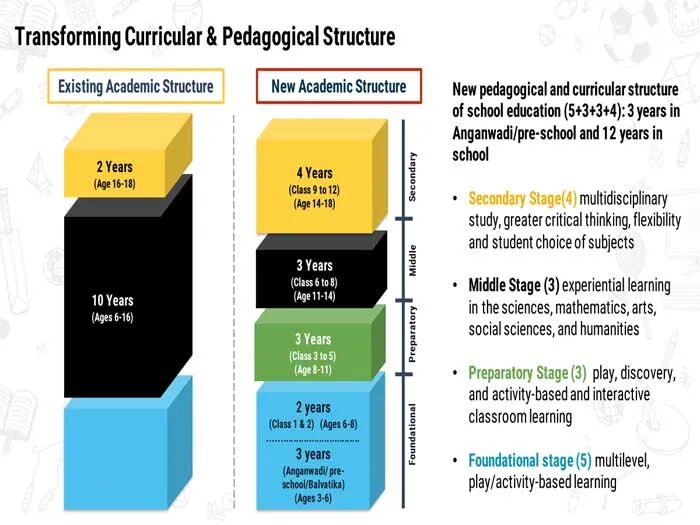Governance
National Curriculum Framework
- 22 Oct 2022
- 5 min read
For Prelims: National Curriculum Framework, NEP, Right To Education
For Mains: Education System in India and related issues
Why in New?
Recently, the Union Education ministry launched the National Curriculum Framework for foundational stage education of children in the three to eight years age group.
What is the National Curriculum Framework?
- The NCF has four sections:
- the National Curriculum Framework for School Education
- the National Curriculum Framework for Early Childhood Care and Education
- the National Curriculum Framework for Teacher Education
- National Curriculum Framework for Adult Education
- The framework focuses on the 'panchakosha' concept - the ancient Indian emphasis on the body-mind connection.
- The NCF says its five parts are physical development (sharirik vikas), development of life energy (pranik vikas), emotional and mental development (manasik vikas), intellectual development (bauddhik vikas) and spiritual development (chaitsik vikas).
- It is an important step taken to implement the New Education Policy-2020.
What is NEP, 2020?
- The National Education Policy 2020 (NEP 2020) is transforming education in India.
- It has set the education system on a path to delivering the highest quality education for all, with equity and inclusion.
- Amongst the most transformative aspects of NEP 2020 is the new 5+3+3+4 curricular structure which integrates Early Childhood Care and Education for all children of ages 3 to 8.
- Early childhood lays the foundation for life-long learning and development - it is a key determinant of the quality of overall life.
What are the Constitutional Provisions and Laws related to Education in India?
- Constitutional Provisions:
- Part IV of Indian Constitution, Article 45 and Article 39 (f) of Directive Principles of State Policy (DPSP), has a provision for state-funded as well as equitable and accessible education.
- The 42nd Amendment to the Constitution in 1976 moved education from the State to the Concurrent List.
- The education policies by the Central government provides a broad direction and state governments are expected to follow it. But it is not mandatory, for instance Tamil Nadu does not follow the three-language formula prescribed by the first education policy in 1968.
- The 86th Amendment in 2002 made education an enforceable right under Article 21-A.
- Article 21A of the Constitution makes it obligatory on the State to provide free and compulsory education to children between the age of 6 and 14 years.
- Related Laws:
- Right To Education (RTE) Act, 2009 aims to provide primary education to all children aged 6 to 14 years and enforces education as a Fundamental Right.
- It also mandates 25% reservation for disadvantaged sections of the society.
- Right To Education (RTE) Act, 2009 aims to provide primary education to all children aged 6 to 14 years and enforces education as a Fundamental Right.
- Government Initiatives:
- Sarva Shiksha Abhiyan, Mid Day Meal Scheme, Navodaya Vidyalayas (NVS schools), Kendriya Vidyalayas (KV schools) and use of IT in education are the result of the NEP of 1986.
UPSC Civil Services Examination Previous Year Question (PYQ)
Prelims
Q. Consider the following statements: (2018)
- As per the Right to Education (RTE) Act, to be eligible for appointment as a teacher in a State, a person would be required to possess the minimum qualification laid down by the concerned State Council of Teacher Education.
- As per the RTE Act, for teaching primary classes, a candidate is required to pass a Teacher Eligibility Test conducted in accordance with the National Council of Teacher Education guidelines.
- In India, more than 90% of teacher education institutions are directly under the State Governments.
Which of the statements given above is/are correct?
(a) 1 and 2
(b) 2 only
(c) 1 and 3
(d) 3 only
Ans: (b)
Mains
Q. National Education Policy 2020 is in conformity with the Sustainable Development Goal-4 (2030). It intends to restructure and reorient education system in India. Critically examine the statement. (2020)






